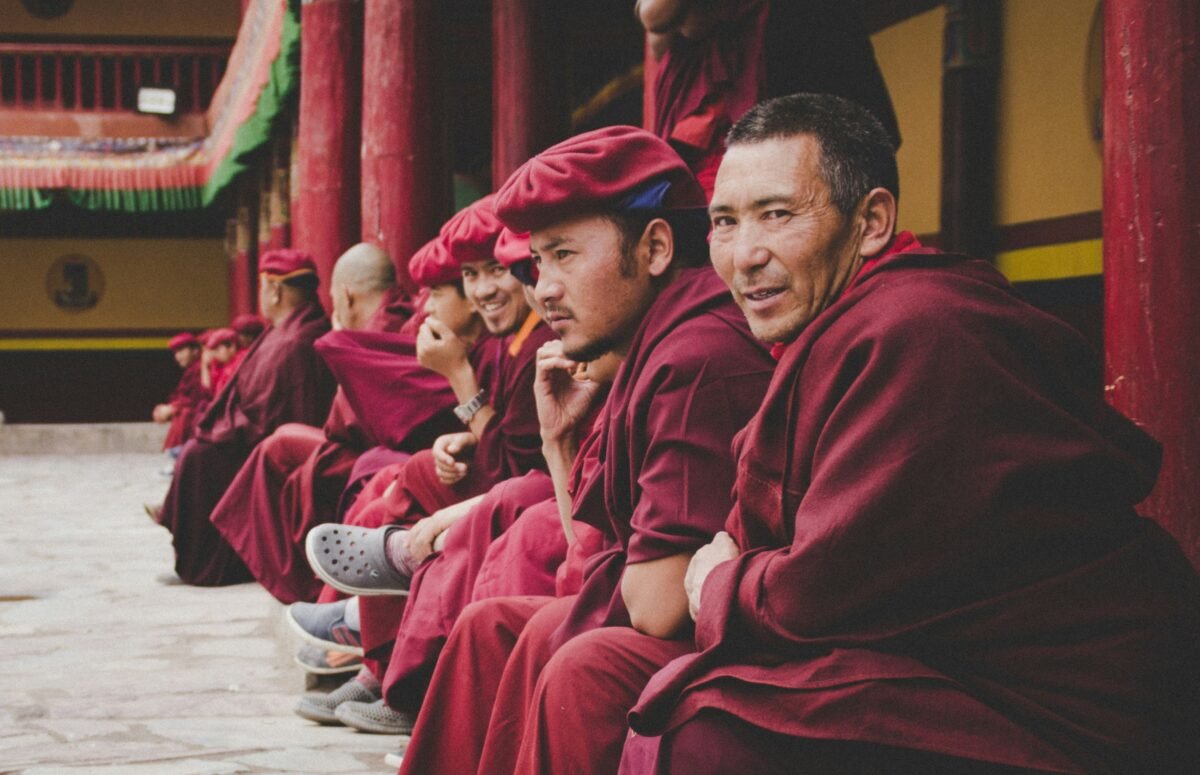India is a land of spiritual resonance, where ancient teachings echo through mountain valleys and temple courtyards. Buddhist Monasteries in India are among the most serene and culturally rich destinations for travelers seeking peace, introspection, and a deeper connection to history. These monastic sanctuaries, scattered across the Himalayas, plains, and forests, offer a glimpse into the life of monks, the rhythm of prayer, and the timeless wisdom of the Buddha.
Whether you’re a pilgrim, a photographer, a cultural enthusiast, or a seeker of silence, visiting these monasteries is a journey into the heart of mindfulness and simplicity.
🕉️ Why Visit Buddhist Monasteries in India?
India is the birthplace of Buddhism, and its monasteries are living testaments to the faith’s enduring legacy. These sacred spaces are not just architectural marvels—they’re centers of learning, meditation, and community.
- Spiritual Atmosphere: Experience the calm of chanting monks, prayer wheels, and incense-filled halls.
- Cultural Immersion: Learn about Tibetan, Theravada, and Mahayana traditions practiced across regions.
- Architectural Beauty: Admire intricate murals, thangka paintings, and traditional Himalayan designs.
- Peaceful Retreats: Ideal for meditation, yoga, and digital detox.
- Living Heritage: Engage with monks, attend teachings, and witness rituals that have remained unchanged for centuries.
🗺️ Top Buddhist Monasteries in India
Here’s a curated list of the most iconic and spiritually enriching monasteries across the country:
| Monastery | Location | Highlights |
| Tawang Monastery | Arunachal Pradesh | Largest monastery in India, stunning Himalayan views |
| Hemis Monastery | Ladakh | Famous for Hemis Festival, rich library of scriptures |
| Rumtek Monastery | Sikkim | Seat of the Karmapa, vibrant Tibetan architecture |
| Namgyal Monastery | Dharamshala | Dalai Lama’s residence, center for Tibetan Buddhism |
| Thiksey Monastery | Ladakh | Mini Potala Palace, panoramic views, morning prayers |
| Ghoom Monastery | West Bengal | Oldest in Darjeeling, houses rare manuscripts |
| Tabo Monastery | Himachal Pradesh | Over 1,000 years old, UNESCO candidate, cave shrines |
| Mindrolling Monastery | Uttarakhand | Ornate stupa, peaceful gardens, Tibetan teachings |
| Phugtal Monastery | Zanskar, Ladakh | Built into a cliff, remote and awe-inspiring |
| Golden Temple | Kushinagar, UP | Mahaparinirvana site, tranquil surroundings |
🧳 Types of Experiences at Buddhist Monasteries
Depending on your interests, here are ways to engage meaningfully with these sacred spaces:
1. Meditation Retreats
Many monasteries offer short and long-term retreats focused on Vipassana, mindfulness, and Tibetan practices. Ideal for spiritual seekers and wellness travelers.
2. Cultural Tours
Explore monastery architecture, attend prayer sessions, and learn about Buddhist philosophy through guided tours.
3. Volunteering & Study
Some monasteries welcome volunteers to teach English, assist in community work, or study Buddhist texts.
4. Festival Visits
Time your trip with vibrant festivals like Hemis Tsechu, Losar (Tibetan New Year), or Buddha Purnima for a deeper cultural experience.
5. Photography & Art
Capture the beauty of thangka paintings, prayer flags, and Himalayan landscapes. Many monasteries also host art workshops.
🕒 Best Time to Visit Buddhist Monasteries in India
Seasonality matters when planning your spiritual journey:
- March to June: Pleasant weather in Himalayan regions like Ladakh, Sikkim, and Dharamshala.
- October to December: Clear skies and cool temperatures, ideal for retreats and photography.
- Festival Seasons: Hemis Festival (June–July), Losar (Feb–March), Buddha Purnima (April–May).
- Monsoon Retreats: Southern monasteries and Mindrolling in Uttarakhand offer peaceful stays during rains.
💡 Tips for Visiting Buddhist Monasteries
To make your experience respectful and enriching, keep these in mind:
- Dress Modestly: Cover shoulders and legs; avoid flashy clothing.
- Observe Silence: Especially during prayer sessions and meditation hours.
- Ask Before Photographing: Some areas and rituals are sacred and private.
- Support Local Shops: Buy handmade crafts, books, and incense from monastery stores.
- Learn Basic Etiquette: Don’t point feet at sacred objects; walk clockwise around stupas.
- Stay Open-Minded: Engage with monks and fellow travelers with curiosity and humility.
🧘♀️ Unique Experiences to Add to Your Monastery Tour
Want to deepen your connection with Buddhist culture? Try these:
- Spin a Prayer Wheel: Symbolic act of spreading compassion and blessings.
- Attend a Teaching by a Lama: In Dharamshala or Rumtek, if available.
- Join a Chanting Session: Feel the vibration of collective prayer.
- Explore Cave Shrines: Like those in Tabo or Phugtal for ancient meditation spaces.
- Participate in Mandala Making: A meditative art form representing the universe.
🛍️ What to Bring Back From Your Monastery Visit
Skip the generic souvenirs—opt for meaningful keepsakes:
- Thangka Paintings: Traditional Buddhist art with spiritual symbolism.
- Prayer Flags: Hang them at home to spread peace and positivity.
- Singing Bowls: Used for meditation and sound healing.
- Books on Buddhism: Teachings of the Buddha, Tibetan texts, or mindfulness guides.
- Handmade Crafts: Incense holders, malas, and monk robes.
🚗 Getting Around Monastery Regions
Transport varies depending on location and terrain:
- Flights: Airports in Leh, Bagdogra, Dehradun, and Guwahati serve key regions.
- Trains: Connect to towns near monasteries like Kushinagar and Darjeeling.
- Buses & Taxis: Widely available in hill stations and pilgrimage towns.
- Walking & Trekking: Essential for remote monasteries like Phugtal or Tabo.
🏨 Accommodation Options Near Buddhist Monasteries
From simple to serene, here are common stay types:
- Monastery Guesthouses: Peaceful and spiritually immersive.
- Budget Hotels: Clean and centrally located.
- Eco-Stays: Sustainable retreats in nature-rich zones.
- Luxury Resorts: Available in Dharamshala, Sikkim, and Ladakh.
- Homestays: Cultural immersion with local families.
✈️ How to Reach Buddhist Monasteries in India
Most monasteries are accessible by air, rail, and road:
- By Air: Leh, Bagdogra, Dehradun, and Varanasi serve key regions.
- By Rail: Indian Railways connects major pilgrimage towns.
- By Road: Scenic drives through Himachal, Sikkim, and Arunachal Pradesh.
📦 Sample Monastery Tour Itineraries
Here are a few curated options from leading providers:
- Himalayan Monastery Trail (7N/8D): Dharamshala → Tawang → Bomdila
- Spiritual Ladakh Circuit (6N/7D): Leh → Hemis → Thiksey → Phugtal
- Sikkim Serenity Tour (5N/6D): Gangtok → Rumtek → Pemayangtse
- Buddha’s Path (10N/11D): Bodh Gaya → Nalanda → Rajgir → Kushinagar
🧭 Final Thoughts
Buddhist Monasteries in India are more than architectural wonders—they’re sanctuaries of silence, wisdom, and timeless tradition. Whether you’re meditating under prayer flags, listening to chants echo through mountain valleys, or simply sitting in stillness, these sacred spaces offer a rare chance to reconnect—with nature, with history, and with yourself.
So pack your curiosity, embrace the quiet, and let the teachings of Buddha guide your journey.


